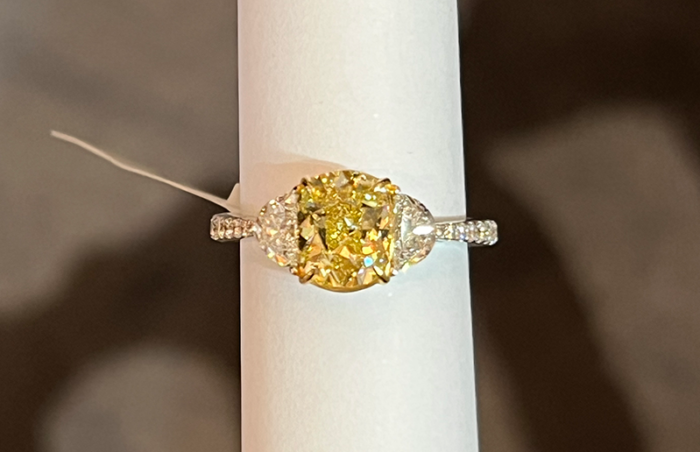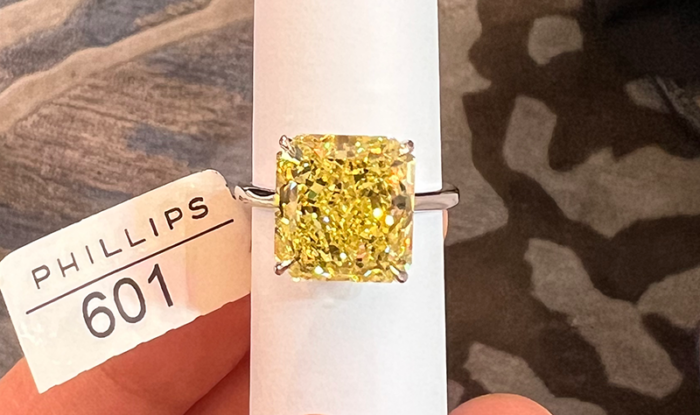Jewels and Jadeite
Our Phillips Hong Kong Pre-Auction Analysis focuses on elements that are not always visible to the untrained eye. We discuss characteristics such as Inner-Grade, Color Dispersion, and Undertone – collectively termed IDU. Professionals use the IDU method intuitively when analyzing a Fancy Color Diamond. The acronym we use makes these elements easier to remember.
Members who read this analysis should see it as a valuable supplement to the GIA report. A detailed explanation of the FCRF’s grading methodology can be found at the end of this article. We recommend reviewing it closely to broaden one’s professional vocabulary for describing fancy color diamonds to clients.
Please note that we analyze and grade diamonds under LED lights and relative to their grade on the GIA report.
The Grades
We use grades 1, 2, 3, and 4, with 1 being the lowest grade. Grade “4+” is granted in rare cases and denotes stones with exceptional characteristics. Stones that receive a minimum total IDU score of 9 without a red remark pass the industry premium threshold and can be traded easily. Fancy Color Diamonds that are graded 10 or above (without a quality remark) are usually sought after by high-end jewelers and collectors.
For your convenience, we have added direct links to diamonds’ GIA reports and FCRF rarity stats.
- All images in this analysis were taken with an iPhone 13 Pro; no filters were applied.
- All auction valuations are per-carat and listed in US Dollars.
Disclaimer
This analysis reflects the opinions of the FCRF professional team. It does not constitute a recommendation to buy or not buy a particular diamond. Buyers assume the responsibility of verifying any information with the auction house. At times, mistakes can happen in the visual analysis and report placement. Therefore, one should not rely solely on this analysis for buying purposes.
__________________________________________________________________________
Lot: 529
Description: 2.01 ct, Fancy Intense Yellow, Cushion, VS1
High Auction Estimation: $ 14,925 pc
Price realized: $15,242 pc
Rarity: 59-71 diamonds yearly – Share this rarity result – Here
GIA Report: View

Analysis:
A 2 carat Fancy Intense Yellow. Looking at the outline of the stone, we can assume that it used to be an oval brilliant that was recut and modified to reinforce its color. In order to stay above the 2 carat weight, the stone could not have been perfected, and as a result, received the Fair symmetry grade and was left with a 73% depth. Several large colorless patches are seen in the crown.
Visual Assets:
Inner-Grade..……………….3
Color Dispersion.………2
Undertone..…………………3
Total Visual Score….8 out of 12
Quality remark: Fair Symmetry and 73% depth
__________________________________________________________________________
Lot: 585
Description: 1.25 ct, Fancy Yellowish Green, Pear, VS2
Description: 1.01 ct, Fancy Yellowish Green, Pear, VS1
High Auction Estimation: $ 32,000 pc
Price realized: $16,410 pc
GIA Report 1338953117: View
GIA Report 2324909538: View


Analysis:
Two Fancy Yellowish Green Pear-shaped diamonds mounted in a setting with a green background to artificially reinforce the face-up view of the stone. Tilting the stone to the side (second image) causes the green coating on the inside of the gold surface covering the pavilion to reflect through the crown facets. As such, we are unable to reliably grade the three visual characteristics.
Visual Assets:
Inner-Grade..……………….N/A
Color Dispersion.………N/A
Undertone..…………………N/A
Total Visual Score….N/A
Quality remark: Green coating within the gold cup to reinforce color
__________________________________________________________________________
Lot: 586
Description: 6.75 ct, Fancy Intense Yellow, Radiant, VVS2
High Auction Estimation: $ 17,777 pc
Price realized: $20,306 pc
Rarity: 13-15 diamonds yearly – Share this rarity result – Here
GIA Report: View

Analysis:
A 6.75 carat Fancy Intense Yellow Radiant-cut diamond with a strong Inner-Grade and no green or brown undertone in the hue. Four large colorless triangles are seen from the face-up view but due to the mounting, are not clearly seen in the video.
Visual Assets:
Inner-Grade..………………3.
Color Dispersion.………2
Undertone..…………………4
Quality remark: none
Total Visual Score….9 out of 12
__________________________________________________________________________
Lot: 600
Description: 2.04 ct, Fancy Intense Pink, Cushion, VS1
High Auction Estimation: $ 122,549 pc
Price realized: $448,345 pc
Rarity: 1-3 diamonds yearly – Share this rarity result – Here
GIA Report: View

Analysis:
A 2.04 Fancy Intense Pink Cushion-cut diamond with a strong Inner-Grade and small colorless patches on the crown. The pink color leans towards a cooler undertone and exhibits a desirable appearance.
Visual Assets:
Inner-Grade..……………….3
Color Dispersion.………3
Undertone..…………………4
Total Visual Score….10 out of 12
__________________________________________________________________________
Lot: 601
Description: 7.18 ct, Fancy Vivid Yellow, Radiant, VVS1
High Auction Estimation: $ 34,818 pc
Price realized: $42,670 pc
Rarity: 8-10 diamonds yearly – Share this rarity result – Here
GIA Report: View

Analysis:
A 7.18 carat Fancy Vivid Yellow Radiant-cut diamond with a strong Inner-Grade, no green or brown undertone, and a high color dispersion.
Visual Assets:
Inner-Grade..……………….3
Color Dispersion.………4
Undertone..…………………4
Total Visual Score….11 out of 12
__________________________________________________________________________
Lot: 607
Description: 1.88 ct, Fancy Deep Grayish Green, Cushion, I3
High Auction Estimation: $ 25,531 pc
Didn’t reach the minimum
GIA Report: View

Analysis:
A 1.88 carat Fancy Deep Grayish Green diamond. This green diamond belongs to a category of diamonds that are left with significant unpolished areas containing patches of color. These unpolished parts are usually covered with green patches created by natural subterranean radiation. These dark green spots look like inclusions and at the same time, reflect a green color within the stone. Most professional buyers refer to these diamonds as “unfinished,” while others appreciate their rare GIA color grade and don’t mind including them in their collection.
In this case, the patches were graded as an i3 clarity, while the unpolished areas made the polish and symmetry receive a Poor grade.
Visual Assets:
Inner-Grade..……………….4
Color Dispersion.………2
Undertone..…………………3
Total Visual Score….9 out of 12
__________________________________________________________________________
General
We use 1, 2, 3, 4, and 4+ to grade the three visual elements that GIA is silent about, although they impact the value dramatically.
Inner-Grade refers to the strength of color within each GIA saturation category:
Grade 1 weakest, bordering the saturation below.
Grade 2 weak (most common).
Grade 3 full-bodied color (above average).
Grade 4 very strong saturation.
Grade 4+ applies to the vivid category only, exhibiting the strongest possible saturation (rarely seen).
Undertone refers to a subtle hue influence in the body color of the stone.
For example:
A Fancy Blue Diamond with a significant gray presence in its general appearance will be graded with a low undertone grade of 1. A Fancy Blue that has no gray influence that is close to a primary blue will receive the grade, 4.
In a Pink Fancy Color Diamond, a stone with a warm undertone (such as orange or brown) will receive a low undertone grade. A pink stone with a cold undertone (such as purple) will receive a high grade.
In Yellow Fancy Color Diamonds, low foreign influence or a light orange influence will grant the stone a high undertone grade. When the yellow undertone looks like a true primary yellow, it will receive the rare grade 4+. Green and brown undertones will grant a low grade in the yellow category.
Color Dispersion relates to how well the color is dispersed in the face-up view of a Fancy Color Diamond, regardless as to whether the GIA grades the stone as even. A stone with many colorless areas will receive the grade 1, while a stone that exhibits its face-up view with no colorless patches will receive the grade 4+. Unlike the first two elements, the color dispersion is not a gemological quality and is the result of cutter proficiency.


